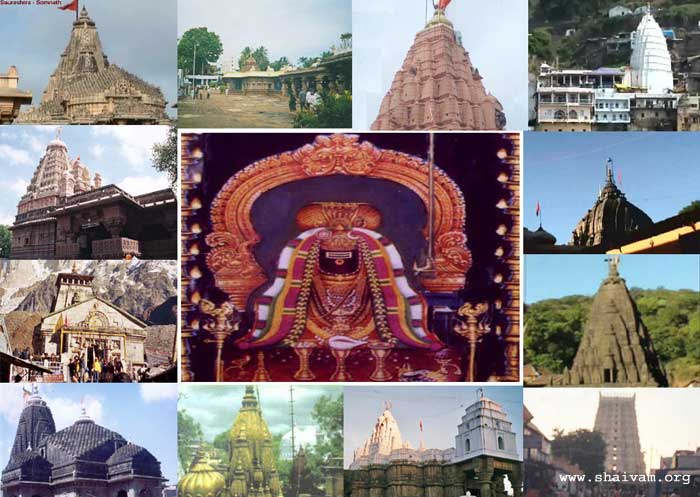12 JyotirLinga Temples
Worship of shivalinga is considered the prime worship for the devotees of Lord shiva. Worship of all other forms is considered secondary. The significance of the shivalinga is that It is the resplendent light (flame) form of the Supreme – solidified to make the worship of It easier. It represents the real nature of God – formless essentially and taking various forms as It wills. More details on the shiva linga significance could be found atShaivam A Perspective.
This jyoti swarUpa of God exist in all the shivalinga forms, there are prominent abodes across Indian subcontinent, where It is in a splendid form. These are renowned asdvAdasa jyotir lingas or 12 jyotirlingas. These are held at much great esteem since the ancient pre-historic times. purANas talk in many sections as well as in detail about the glory of these abodes. Devotees have been getting pulled towards these kshetras due to the highly benevolent divine presence in these abodes, since ancient times.
12 Jyotirlinga Temples Sloka
“Saurashtre Somanathamcha Srisaile Mallikarjunam|
Ujjayinya Mahakalam Omkaramamaleswaram ||
Paralyam Vaidyanathancha Dakinyam Bheema Shankaram |
Setu Bandhethu Ramesam, Nagesam Darukavane||
Varanasyantu Vishwesam Tryambakam Gautameethate|
Himalayetu Kedaaram, Ghrishnesamcha shivaalaye||
Etani jyotirlingani, Saayam Praatah Patennarah|
Sapta Janma Kritam pApam, Smaranena Vinashyati||”
In this video join us on a divine journey through the 12 Jyotirlingas, the most sacred Shiva temples spread across India. These powerful shrines are believed to be manifestations of Lord Shiva’s radiant cosmic energy. Each Jyotirlinga has a unique legend, signifying Shiva’s presence and divine blessings. From Somnath in Gujarat to Rameshwaram in Tamil Nadu, discover the history, mythology, and spiritual significance of these holy sites.
00:01 – The Story of Somnath Jyotirlinga (Gujarat)
05:39 – Mallikarjuna Jyotirlinga (Andhra Pradesh)
06:30 – Mahakaleshwar Jyotirlinga (Madhya Pradesh)
07:45 – Omkareshwar Jyotirlinga (Madhya Pradesh)
08:53 – Kedarnath Jyotirlinga (Uttarakhand)
09:58 – Bhimashankar Jyotirlinga (Maharashtra)
11:03 – Kashi Vishvanath Jyotirlinga (Uttar Pradesh)
12:07 – Trimbakeshwar Jyotirlinga (Maharashtra)
12:52 – Vaidyanath Jyotirlinga (Jharkhand)
14:03 – Nageshwar Jyotirlinga (Gujarat)
15:06 – Rameshwar Jyotirlinga (Tamil Nadu)
15:51 – Grishneshwar Jyotirlinga (Maharashtra)
The following sanskrit sloka ( द्वादश ज्योतिर्लिंग स्तोत्रम्) (Dwadasha Jyotirlingum Strota) describes about the 12 Jyotirlingas –
सौराष्ट्रे सोमनाथं च श्रीशैले मल्लिकार्जुनम्। उज्जयिन्यां महाकालमोङ्कारममलेश्वरम्॥
परल्यां वैद्यनाथं च डाकिन्यां भीमशङ्करम्। सेतुबन्धे तु रामेशं नागेशं दारुकावने॥
वाराणस्यां तु विश्वेशं त्र्यम्बकं गौतमीतटे। हिमालये तु केदारं घुश्मेशं च शिवालये॥
एतानि ज्योतिर्लिङ्गानि सायं प्रातः पठेन्नरः। सप्तजन्मकृतं पापं स्मरणेन विनश्यति॥
एतेशां दर्शनादेव पातकं नैव तिष्ठति। कर्मक्षयो भवेत्तस्य यस्य तुष्टो महेश्वराः॥:
द्वादश ज्योतिर्लिंग स्तोत्रम्
English Conversion
“Saurashtre Somanathamcha Srisaile Mallikarjunam|
Ujjayinya Mahakalam Omkaramamaleswaram ||
Paralyam Vaidyanathancha Dakinyam Bheema Shankaram |
Setu Bandhethu Ramesam, Nagesam Darukavane||
Varanasyantu Vishwesam Tryambakam Gautameethate|
Himalayetu Kedaaram, Ghrishnesamcha shivaalaye||
Etani jyotirlingani, Saayam Praatah Patennarah|
Sapta Janma Kritam pApam, Smaranena Vinashyati||”
English Translation(Literal)
Somanath in Saurashtra and Mallikarjunam in Shri-Shailam. (सौराष्ट्रे सोमनाथं च श्रीशैले मल्लिकार्जुनम्).
Mahakaal in Ujjain and Amleshwar in Omkareshwar. (उज्जयिन्यां महाकालमोङ्कारममलेश्वरम्).
Vaidyanath in Paralya and Bhimashankaram in Dakniya. (परल्यां वैद्यनाथं च डाकिन्यां भीमशङ्करम्).
Rameshem (Rameshwaram) in Sethubandh and Nageshem (Nageshwar) in Darauka-Vana. (सेतुबन्धे तु रामेशं नागेशं दारुकावने).
Vishwa-Isham (Vishvanath) in Vanarasi and Triambakam at bank of Gautami River. (वाराणस्यां तु विश्वेशं त्र्यम्बकं गौतमीतटे)).
Kedar (Kedarnath) in Himalayas and Gushmesh (Gushmeshwar) in Shivalaya (Shiwar). (। हिमालये तु केदारं घुश्मेशं च शिवालये).
One who recites these Jyotirlingas every evening and morning. (एतानि ज्योतिर्लिङ्गानि सायं प्रातः पठेन्नरः।).
He is relieved of all sins committed in past seven lives.(सप्तजन्मकृतं पापं स्मरणेन विनश्यति)
One who visits these, gets all his wishes fulfilled (एतेशां दर्शनादेव पातकं नैव तिष्ठति)
and one’s karma gets eliminated as Maheshwara gets satisfied to the worship:(कर्मक्षयो भवेत्तस्य यस्य तुष्टो महेश्वराः)

